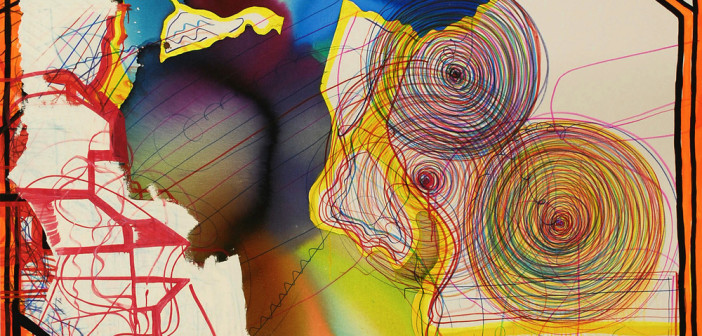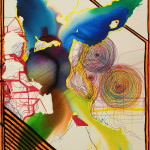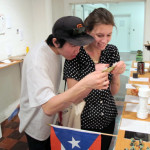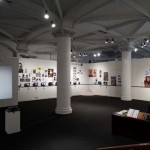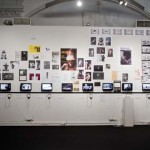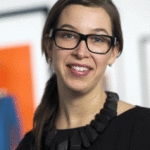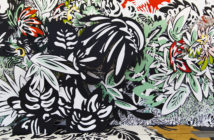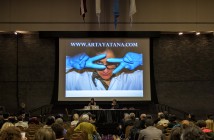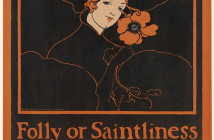Sarah Sulistio Before becoming the Director and Chief Curator of the Boston University Art Gallery, you were a curator at MoMA PS1 and one of the founders of Cleopatra’s in Brooklyn. Arguably, your move to Boston University could be seen as surprising, given the time in your career. So what attracted you to curating and managing a university gallery, specifically one in Boston?
Kate McNamara I had been involved in a number of exciting projects and institutions in New York previous to coming to Boston University and had been working in a curatorial capacity on and off in NYC for almost 7 years. While working at both MoMA PS1 and Cleopatra’s, I was asked by my undergraduate college, Hampshire College, to assist in rethinking their university gallery model. This process brought me to Hampshire several times to lecture on the potential of the university gallery within the student community, 5-college consortium, the area of Western Mass and New England at large. With every conversation and lecture, I returned to New York thinking about the role a college university can play within an institution, even a city. This new focus and an interest in gaining some perspective outside of NYC brought me to a curatorial residency in the Belgian city of Antwerp, where I found myself spending time with various academies and university galleries. It was not long after that I decided not to return to New York and instead pursued the position of Boston University’s gallery director.
SS What do you feel is the role of the university gallery in the local Boston art scene? How are the exhibitions and programming at a university gallery different from those in a museum institution and commercial gallery?
KM The university art gallery plays a very significant and unique role in Boston. University galleries in this city outnumber commercial galleries, alternative art spaces and museums; therefore they make up a vital component of the Boston art world. These spaces vary in their focus, collections, and missions, however each contribute an important conversation about art and often sustain an interdisciplinary approach to programming afforded by the diversity embedded in an academic environment. These galleries and museums do not always necessitate collections, the input or supervision of a board — such as museums, and certainly do not facilitate sales as a commercial gallery relies upon. Unlike many of the university galleries in Boston, the BU Art Gallery does not have a collection, so it actually functions more as a Kunsthalle and sustains a reactive flexibility, which means it can be more responsive to various trends, contemporary conversations, as well as topics the university may be in engaged with.
SS What challenges would you say you face with organizing exhibitions in a university setting? How much autonomy does the gallery have from the university institution? And how do your curatorial intent and the public program change when situated in the university and addressed to public of, primarily, students and faculty?
KM Coming from a contemporary art museum (MoMA PS1), I was in a dialogue with an international audience made up of other art institutions, curators, artists and an audience based in one of the world’s primary art hubs—New York City. At the BU Art Gallery, my primary audience is comprised of students and faculty. My interest in this kind of gallery, however, is the potential of a university gallery to act as a hub. By ‘hub,’ I mean a site that is situated within a diverse and interdisciplinary conversation, context and communities. Beyond the BU-based audience, my hope is that the diversity in programming reaches audiences in Boston, New England, and the United States and beyond. I believe this can be achieved by engaging an intergenerational, multi-disciplinary, collaborative, porous, and discursive exhibition and public program that exists beyond the physical gallery site and university parameters. Once examples of this has been in the shape of publications produced in relation to exhibitions. These books have taken the shape of ‘zines, artist books, and CDs—an attempt to further disseminate ideas, push an exhibition or artist outside the confines of the gallery, and produce another site for exhibition and art production.
SS At BU AG you wear many hats—from curating exhibitions, to managing the gallery’s day-to-day, to organizing the public program. How do your past experiences inform and differ from the responsibilities you now have? What about telling us how your expectations of curating a university gallery differed from the realities that you know now?
KM It’s true, this is a small operation that is very hands-on and necessitates physical presence. I am one of two full-times employees here at the gallery. That said, my previous experiences, which have existed in the non-profit sector of the art world, have always necessitated the need to wear many hats and be a hands-on presence. I think this multidimensional role speaks largely to the ever-changing description of a curator. Organizer, facilitator, mediator, advocate, administrator, janitor, editor, and producer are all a part of the job and all speak to my working definition of what a curator does.
SS Apart from your position at BU AG, you also teach visual art and art history classes at BU. How has your curatorial practice informed or affected your teaching practice or vice-versa? What do you think is important to impart to your students about art and curating today?
KM Teaching has been one of the more exciting and challenging aspects of my position here at BU. I think both my curatorial practice and continuous dialogue with communities of artists and art practitioner over the years all come together to inform my teaching practice. Many of the conversations and course topics discussed in both the art historical and visual arts courses are vibrant ongoing considerations for me as a curator of contemporary art and I feel with each class students are building on very present concerns, discourses, and ideas that are currently fueling the art world. I learn a great deal from my students. There has been an immense push on the professionalization of both the artist and the curator and I believe it is extremely important for aspiring artists and curators to understand that they have the power to create their own discourses within the art world.
SS You have vast experience and immense passion for curating performance art, with bringing the exhibition 100 Years of Performance Art from MoMA PS1 to the gallery and your involvement in the local performance art scene. Not to give away too much of what you’ll be speaking about at the BR&S and MFA panel, but what can you comment about the university gallery as an arena for performance art? How can performance art as a medium and discipline grow in the university gallery and how do you think it can impact the visual art education at BU?
KM Again, I think the university art gallery can play a subversive role in the production of art discourses—a place to practice and to experiment, as Samuel Beckett famously said, "fail better." Performance is such a fascinating expression, as it is finally entering the art institution as an "acceptable" art discipline, it also brings up so many complex conversations about how we define the term. Many museums have relegated performance to discrete spaces like MoMA PS1’s performance dome and the Tate Modern’s TANK, in other situations we see performance relegated to public programming. RoseLee Goldberg founded Performa, which is a performance biennial—temporal in its structure and engaging multiple sites throughout NYC. Then we have encyclopedic museums like the MFA attempting to bring performance into the galleries, which presents a whole new set of conditions to consider. I think the university gallery has the potential to be a laboratory for performance art—it allows you to see the process as it is forming.
- Joanne Greenbaum, Untitled “SIMPATICO” September 7 – October 21, 2012 BU Art Gallery image courtesy of BU AG
- “Trading Post” with John Gonzalez February 21 – March 4, 2012 BU Art Gallery Annex image courtesy of BU AG
- 100 Years (version #4 Boston, 2012) January 19 – March 25, 2012 BU Art Gallery
- 100 Years (version #4 Boston, 2012) January 19 – March 25, 2012 BU Art Gallery
- Kate McNamara Photo courtesy of www.bu.edu
This interview was conducted in light of the upcoming performance art event at the MFA Boston, Odd Spaces, and the panel discussion that will follow.
More information on mfa.org

